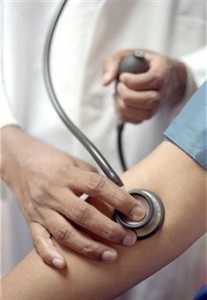Weight and body mass index (BMI) are used to calculate whether a person is normal, overweight or obese. Recent studies conclude that waist measurements might also indicate health risks.
Data analyzed from 11 studies involving 650,386 adults, most in their early 60s over a nine year span concluded that people with the largest waist sizes were most likely to die at a younger age from cardiovascular disease, respiratory disease, or cancer than those with smaller waists.
Men whose waists measured 43 inches or more were 52 percent more likely to increase their risk of death than men with 35-inch waists; women with 37-inch or larger waists had an 80 percent higher mortality risk than those with waists of 28 inches or less. The chances of dying prematurely increased 9 percent for women and 7 percent for men for every two-inch increase in waist size. Compared with those who had the smallest waists, men with the largest waists had a life expectancy that was three years shorter; for women, five years shorter. The elevated likelihood of dying early applied across the board, affecting even people with normal BMIs.
According to the Journal of the American College of Cardiology, this “obesity paradox” is because BMI does not distinguish between fat and muscle it is a flawed measure of heart risk. Waist size provides a far more accurate way to predict a patient’s chances of dying at an early age from a heart attack or other causes. BMI measurements are still important, but other considerations such as body shape and fat distribution should also be factored in.
Do you know your waist circumference? Here’s how to measure it:
Locate your hip bone on your abdomen.
Wrap a measuring tape around your body at this level. It should be snug but not pressing into your bare skin.
The tape should be parallel to the floor. Relax, exhale and read the measurement.
Being physically active, eating well and watching portions can make a positive impact on your waist and overall health. Discuss your health risks and goals with your medical provider.
All content of this newsletter is intended for general information purposes only and is not intended or implied to be a substitute for professional medical advice, diagnosis or treatment. Please consult a medical professional before adopting any of the suggestions on this page. You must never disregard professional medical advice or delay seeking medical treatment based upon any content of this newsletter. PROMPTLY CONSULT YOUR PHYSICIAN OR CALL 911 IF YOU BELIEVE YOU HAVE A MEDICAL EMERGENCY.





